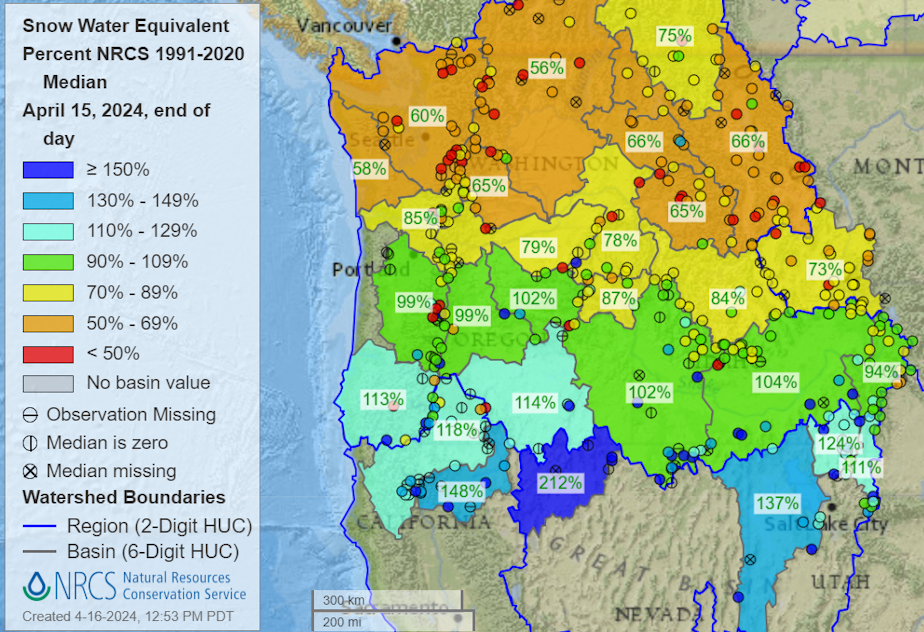Drought emergency declared for Washington state ahead of warm summer
A drought emergency was declared for the state of Washington Tuesday, as state officials face low water supply ahead of an expected warmer-than-normal summer across the region. Seattle, Tacoma, and Everett are excluded from the emergency declaration.
"We depend on that winter snowpack to meet the needs of Washington’s farmers, fish, and communities during the dry summer months. And this year, it’s just not at the level we’re accustomed to and rely on," Gov. Jay Inslee said in a statement.
RELATED: As the Northwest spring arrives, so do anxieties over water for farming, and summer wildfires
The Washington State Department of Ecology declared the drought emergency April 16, 2024. The department makes such a declaration when the state's water supply is less than 75% of normal. Current statewide snowpack is at 68% of normal; however, regions like the Olympic Mountains are much lower. This means that streams are running lower and warmer. For example, the Dept. of Ecology points to the Chelan River where streamflow is at 52% of normal.
Caroline Mellor, statewide drought lead with the Department of Ecology, noted that Everett, Seattle, and Tacoma have strong water management strategies that make them more resilient to the drought. That is why these areas have been excluded from the emergency declaration.
"For Everett, and Seattle, and Tacoma, on those utilities that have large reservoirs, that allows them to more actively manage their water supplies," said "And they have been able to manage their supplies looking at conditions coming into the spring and summer ... and so they do not currently, nor anticipate facing any hardship for their water supplies. That's specifically for those three utilities."
By making the declaration, $4.5 million in drought-response grants will be opened up to public agencies to help mitigate complications from low water supplies. It also allows Ecology to handle emergency water right permits.
Sponsored

Washington state emergency drought declaration 2024
The current situation in Washington state has been long in the making. The department notes that Tuesday's declaration is "really a continuation of 2023’s drought emergency." That declaration was slated to end in June of this year; however, the recent El Niño weather pattern meant that enough rain did not fall to make up for 2023's loss.
Last winter was relatively dry. This came after Seattle was asked to conserve water in the fall due to low supply. The Seattle area then recorded its warmest December on record. Projections for summer 2024 indicate warmer than normal temperatures.
“What that actually means, in practice, is that we are facing what's called a ‘snowpack drought'," Mellor said. "A snowpack drought is different than just a regular rain or precipitation drought, because this means that most of our precipitation has come as rain instead of snow, or that snow has melted much earlier than it would in a normal year; we would expect the snow melt to happen gradually throughout spring and summer from the mountains”
“The Olympic basin is at 61% of normal for snowpack,” she said. “And North Puget Sound, that includes the North Cascades, is at 57% of normal … Lower Yakima, for that basin, they’re at 46% of snowpack. That's really concerning, because that means that water that's held in that snowpack either has already melted out to the ocean, or will be melting out a lot earlier. We are already seeing lower-than-normal streamflow conditions, as well as a clear forecast for continued or worsening streamflow conditions for April to September."
Mellor said people can expect to see streams drying up sooner than expected, especially in August. This will affect irrigation and recreational fishing.
Ecology said that many watersheds are already projecting low water supplies over the coming warm months. For example, water systems in Clallam County and Whatcom County are now trucking in water to meet demand. Mellor said Ecology anticipates that water may need to be trucked into the Olympic Peninsula this summer.
“There are clear impacts that we expect for water users and the environment across the state," Mellor said. "Specifically for agriculture, there are a number of impacts expected for irrigators and other agricultural sectors, as well as for domestic drinking water supplies, particularly for rural areas on smaller drinking water systems.”
Mellor said that drought declarations have increased over the past 10 years, since the "historically warm and dry drought of 2015." Washington has declared drought in six of the last 10 years.
"I will say, while these conditions are not as bad as 2015, we are already seeing these conditions in April. And with forecasts for warmer temperatures way above normal, and somewhat below normal precipitation, we have no expectation that these conditions will improve. We expect that they'll either stay the same or get worse in terms of drought conditions across the state."
Looking ahead, Mellor recommends that Washingtonians consider drought-tolerant plants for gardening, and using low-water-use gardening practices, like a hose timer. Also, only run dishwashers when they are full.




